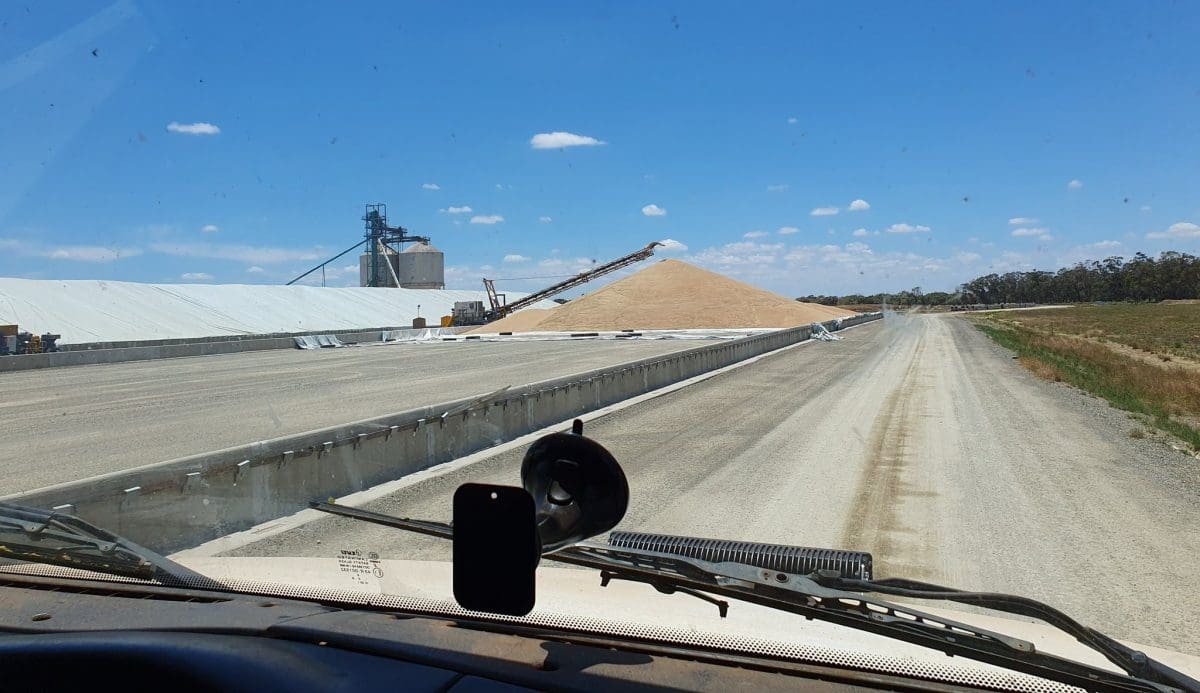
A wheat stack grows at he Manildra site at Bogan Gate in central NSW. Photo: Mark Mortimer
TIGHT logistics have helped to lift prices for northern cereals this week, while harvest pressure has borne down on barley markets in Victoria and South Australia.
Apart from Queensland, where harvest is mostly finished, Australia’s winter-crop regions generally had a dry week, allowing significant harvest progress to be made.
Continuing to surprise has been the quality of the NSW wheat crop, which has seen the spread between SFW, ASW and APW wheat compress now that flour millers have coverage on better grades and near-term export needs are covered.
Trade sources believe growers are prioritising quality grain, canola and pulses for harvest, and large volumes of low-quality grain will hit the market, or fill on-farm storages, when headers get into it in January.
To help accommodate off-spec wheat, GrainCorp has this week opened an AUH3 segregation, which tolerates up to 10pc distorted grain and has a minimum protein requirement of 11pc.
| Prompt | Dec 1 | Jan-Feb | Dec 1 | |
| Barley Downs | $380 | $378 | $385 | $388 |
| SFW wheat Downs | $390 | $385 | $392 | $390 |
| Sorghum Downs | $400 | $420 | $380 | $385 |
| Barley Melbourne | $365 | $385 | $350 | $365 |
| ASW Melbourne | $432 | $430 | $405 | $415 |
| SFW Melbourne | $427 | $405 | $395 | $400 |
Table 1: Indicative prices in Australian dollars per tonne.
Spreads narrow in north
Northern values are being supported by near-term export demand for wheat in competition from domestic feedmills looking to book enough loads to get them well into January.
“I think the consumer is pretty well covered; it’s the trade that could be holding the short,” RainAg broker Scott Merson said.
While low falling numbers, an indicator of sprouting, have been evident in some NSW wheat crops, Queensland quality has generally been outstanding, and crops being harvested in NSW are coming in with better-than-expected specifications.
“Down through Central West NSW, H2 is coming off; that’s a surprise.”
The big crop being harvested on top of significant carry-out has supply chains groaning, and middle-of-the-road wheat appears destined for the feed market.
“With the way quality’s been better than expected, we’ll see better grades being fed.”
Mr Merson said the north’s APW wheat appears to be destined for export, and lower grades are competing with barley in the feed market.
“I don’t know that we’ll see feedgrain soften.”
Logistics remains very difficult, with the Queensland rail network said to be flat out moving grain from full storages to port, and trucks booked up to supplement capacity.
That has left some domestic consumers scrambling to get coverage because of issues tied to outturn from bulk handlers, and availability of trucks.
Darwalla Milling feeds manager Gary Heidenreich said the delivered Brisbane market was sitting at around $415-$430/t for sorghum, wheat and barley, with wheat at top dollar.
“We should be going to wheat from sorghum, but we can’t get it.
“You’d have to buy it at $425-$430.”
Southern barley sinks
Barley prices in South Australia and Victoria have tumbled, with indications that malting production is higher than expected due to the mild finish to the season, and maltsters have pulled back their buying now that adequate coverage has been achieved.
The painfully slow start to the wheat harvest in Victoria and southern NSW is supporting wheat’s inverse to new-crop in the south, but harvest pressure in barley has seen its inverse shrink.
One trade source said harvest in the south was a fitful process, based on boggy conditions still evident in many paddocks, and mild conditions which have delayed crop ripening.
“Whatever’s ready, get it; there’s no uniformity to it.”
Low test weights are seeing a reasonable proportion of deliveries into F2 with a “smattering” of F3, and adequate amounts of F1 are rolling in for those consumers who are wedded to it in their rations.
“Wheat proteins are holding up; that’s a big surprise.”
“Wheat’s just starting in Vic, and there are premiums for prompt delivery.”
In South Australia, Growth Grain Services principal Jack Zacker said the delivered Adelaide feed barley market is now at around $270/t, down roughly $80/t in the past month.
“There has been a lot of grower selling, and there’s a lot of feedgrain around and a lot of volume hitting the market.”
“With consumers, it’s the guys who haven’t got the coverage that are the winners at this stage.”
Also in SA, Vater & Co director Kim Vater said markets have weakened considerably on supply-side pressure.
“Everything’s plummeted fairly well, and the massive yields over here have something to do with it.”
Grain Central: Get our free news straight to your inbox – Click here

HAVE YOUR SAY